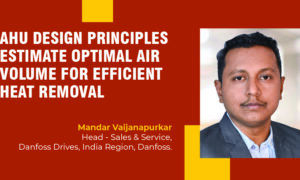Control systems ensure spread of fresh air into the space which varies from location to location inside the building based on occupancy and activity.
Thermal comfort has multiple dimensions for public utilities and large buildings. Now, the scope of dimension is on the integrated comfort system, controls, and HVAC systems. How they work together to get what we want, what an end user expects and what the occupant expects in the location is needed now more than ever. Digitalisation plays a significant role nowadays. So many things have changed over time, including technological advancements in the equipment for air conditioning buildings.
Need for thermal control and thermal comfort
In earlier times, air conditioning was negligible due to a lack of equipment, technology, or say temperatures were not as high. Either the population was small or occupancy levels were lower. Today, occupant density is much higher in a building known as a confined space. And, talking about the built environment means air conditioning. The technology for manufacturing equipment and controls has improved. The future is IoT since digitalisation is everything for thermal control. Generally, the air conditioning cycles include the air side, chilled water side; the refrigeration cycle, and the heat rejection cycle. The control system connects these and coordinates. The designing of the system in building has to be done in such a way that the MEP and air conditioning equipment installed may address the peak load demand of the building. All of these systems must operate in different modes, different control modes, in different climates and seasons.
Variable air volume system
Varying the air volume is done through variable air volume boxes which have a lot of microprocessors inside the box, including an air handling unit that cools the air and spreads the cold air into the space. The controls, field devices and methodologies help achieve thermal comfort based on the occupant requirements. Such a large structure may be a healthcare center, a commercial office space or a public space.
Thermal comfort implies temperature, humidity, noise, filtration, all kinds of indoor air, volatile organic compounds and various other aspects. All of this can be handled by installing an energy efficient air conditioning system for comfort inside the spaces. The air handling units with variable air handling systems pump air into the build space but unnecessary pumping of air is to be avoided. All of this is possible with proper system design as well as a control system, built alongside the equipment; whether it is VRF, chilled water system, air or water cooled, evaporative cooling, natural ventilation, or a mixed mode system. The variable air volume system takes care of all kinds of complicated programmes.
A building automation system controls the temperature, humidity, and CO2 levels – primary components of indoor environmental quality and comfort. The BMS informs what kind of temperature is maintained into locations inside a big space. These are important components in a building to help achieve thermal comfort as well as energy savings. Mapping of occupancy layout with temperatures; floor heat map screen and floor lighting management system can be coupled with optimum air conditioning.
Variable fresh air
ASHRAE and ISHRAE defined the amount of fresh air needed to pump into the building based on occupancy and activity. The fresher quantity varies depending on whether it’s a library, office space, factory air conditioning, or some other application, but practically, all the people are not going to occupy one single location right from morning to evening. There are methods by which the control system ensures that the amount of fresh air given into the space is determined by demand, which varies from location to location. And there are equipment like air handling units, package units, VRF systems. The state of the art technology has been improving and advancing every day. It is aimed at saving energy and thermal comfort.
Regardless of the system, controls are required because cooling load varies throughout the year. There are improvements, when a person leaves office space, the lights will turn off in that cabin or meeting room, and the air conditioning system will also enter into an unoccupied mode. So, the occupied mode, unoccupied mode, and building integration can be achieved through software integration of ASHRAE BACnet standards integrated with the lighting management system.
Challenges in Building Operations
Today multiple challenges in building operations have given rise to a plethora of opportunities. The facility managers and maintenance personnel view things from different perspectives. It is through proper design of the HVAC system and the controls required for that. Currently, IoT is catching up quickly. Data is the prime need today and the volume of information is increasing at a rapid pace. Artificial intelligence and machine learning are there however, the fundamentals of heat transfer have not changed. Achieving air conditioning, either through small split air conditioners, evaporative cooling or a chilled water system, has not changed. A lot of cloud IoT applications and wireless equipment are available today.
The challenge for the control industry is to determine how they all fit together and operate as an integrated system. With use of MQTT protocol, data can be stored in the cloud. Buildings are becoming more complex nowadays. To have control over everything is possible with a good building automation system, good controls, and a well designed HVAC system. Today, data sourcing and collection is considered to be a single piece of information and the equipment contains a lot of intelligence. Approaches for analytical logistics, AI technologies, cloud data analysis, and achieving the synergy of options among other things are mostly relevant for large structures.
Cookie Consent
We use cookies to personalize your experience. By continuing to visit this website you agree to our Terms & Conditions, Privacy Policy and Cookie Policy.














